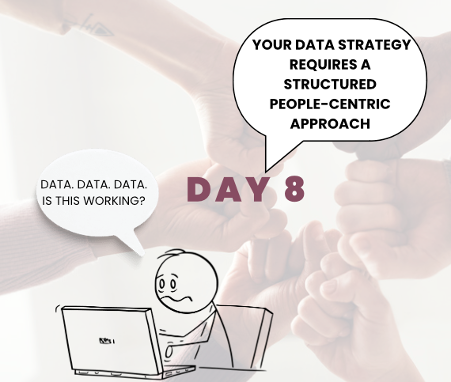
Day 8: The Role of Data in AI & GenAI Success – A People-Centric Approach
Day 8: The Role of Data in AI & GenAI Success – A People-Centric Approach
Welcome back to Day 8 of the GainX AI Blueprint and blog, AI².
When we talk about AI and GenAI, we often focus on data as the key driver of success. But behind every data initiative lies a complex web of people, each with their own concerns, motivations, and challenges. For AI & GenAI to truly succeed, it’s crucial to understand the human side of the equation—particularly when it comes to soliciting buy-in from stakeholders and uniting various business units to pool their data for the greater good of the company.
The Challenge: Navigating Organizational Silos and Resistance
For those tasked with leading data initiatives, the journey can often feel like an uphill battle. Organizational silos, conflicting priorities, and the natural resistance to change can create significant roadblocks. People may question the value of pooling their data, fearing that it could lead to increased scrutiny, loss of control, or simply more work without a clear benefit.
Overcoming These Barriers: Building Trust, Showing Value, and Ensuring Early Involvement
The key to overcoming these challenges is to build trust, demonstrate the value of a unified data strategy, and ensure early involvement across all levels. This “real involvement” is crucial—not just for creating excitement and urgency but also for preventing significant hidden costs that could arise if these challenges are not addressed early on.
Ignoring or delaying the engagement of stakeholders might seem easier in the short term, but it can lead to entrenched silos, misaligned goals, and ultimately, a fragmented AI strategy. These hidden costs can manifest as duplicated efforts, resource wastage, and missed opportunities for innovation, all of which can derail your AI & GenAI initiatives.
By facing these challenges early, you set a solid foundation for success, ensuring that your organization is fully aligned and ready to leverage AI for maximum impact. It’s an investment in your future—one that pays off in streamlined processes, improved decision-making, and a stronger competitive position.
1. Clear Communication (Months 1-2): Start by clearly articulating the purpose and benefits of the AI & GenAI initiative. Explain how pulling data together across the organization will lead to better insights, more informed decision-making, and ultimately, greater success for everyone involved. For larger organizations (e.g., 75,000 employees), this phase might extend to 3-4 months, as reaching all stakeholders requires a more structured communication strategy. Leadership should plan to invest in consistent, multi-channel communications (e.g., town halls, internal newsletters, dedicated AI strategy sessions) and ensure that the message is aligned across all levels of the organization.
2. Small Wins (Months 3-6): Begin with small, manageable projects that can quickly demonstrate the value of a unified data approach. For a 5,000-person company, this could involve pilots within key departments or business units. Larger organizations might need to run multiple pilots in parallel to cover different regions or divisions. This phase is crucial for building momentum, so it’s important to measure and communicate the success of these initiatives widely. Leadership should ensure that these small wins are shared through internal communication channels to build excitement and demonstrate progress.
3. Involvement and Ownership (Months 6-9): Engage stakeholders early and often. Make them feel like active participants in the process, rather than passive contributors. In organizations of 75,000 people, this might involve creating cross-functional teams or committees that represent different areas of the business, ensuring diverse perspectives are included. Leadership should plan for ongoing investment in training and workshops to build ownership and foster collaboration. Regular feedback loops should be established to measure alignment and clarity as the initiative progresses.
4. Address Concerns (Ongoing): Acknowledge the fears and concerns people may have, whether it’s about workload, data privacy, or the potential impact on their roles. Be transparent about how these issues will be managed and offer support throughout the process. For both small and large organizations, this step is continuous and should be revisited regularly. Leadership should measure the effectiveness of their communication strategies and the clarity of alignment with the overall vision. Investing in regular pulse surveys and check-ins can help gauge employee sentiment and ensure that concerns are being addressed in real-time.
Inspiring and Exciting Your Team: A Shared Vision
To truly excite your fellow employees and stakeholders, it’s important to paint a vision of what’s possible. Help them see the bigger picture—the innovative solutions, the improved customer experiences, the competitive edge—that a successful AI & GenAI initiative can bring. When people understand that they are part of something transformative, they are more likely to engage with enthusiasm and commitment.
The Human Element: The Heart of AI & GenAI Success
At the end of the day, data is only as powerful as the people who manage and utilize it. By taking a people-centric approach, you can not only overcome the challenges of data unification but also foster a culture of collaboration and innovation that drives long-term success.

